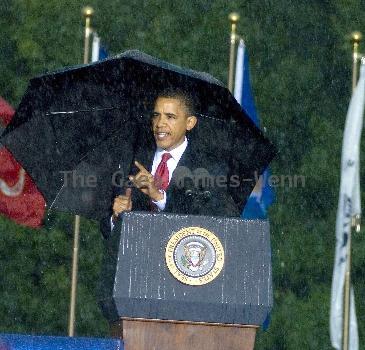Cap collects some of the Gulf oil gusher, unclear how much; crude washes into Fla.
By Greg Bluestein, APFriday, June 4, 2010
Cap collects some Gulf oil; crude washes into Fla.
PENSACOLA BEACH, Fla. — Waves of gooey tar balls crashed into the white sands of the Florida Panhandle on Friday as BP engineers adjusted a sophisticated cap over the Gulf oil gusher, trying to collect the crude now fouling four states.
Even though the inverted funnel-like device was set over the leak late Thursday, crude continued to spew into the sea in the nation’s worst oil spill. Engineers hoped to close several open vents on the cap throughout the day in the latest attempt to contain the oil.
As they worked on the system underwater, the effect of the BP spill was widely seen. Swimmers at Pensacola Beach rushed out of the water after wading into the mess while children played with it on the shore and others inspected the clumps with fascination, some taking pictures. Brown pelicans coated in chocolate syrup-like oil flailed and struggled in the surf on a Louisiana island, where the beached was stained in hues of rust and crimson, much like the color of drying blood.
“In Revelations, it says the water will turn to blood. That’s what it looks like out here — like the Gulf is bleeding,” said P.J. Hahn, director of coastal zone management for Plaquemines Parish as he kneeled down to take a picture of an oil-coated feather. “This is going to choke the life out of everything.”
President Barack Obama was in Louisiana, his second trip in a week and the third since the disaster unfolded following an April 20 oil rig explosion. Eleven workers were killed.
Obama got a briefing on the spill and said progress was being made but that it was “way too early to be optimistic” about BP’s latest attempt. He criticized BP for spending on advertising and shareholder dividends, saying the company must not do that if it’s “nickeling and diming” local businesses and workers.
In Grand Isle where the president was headed, the once-bustling fishing pier was filled not with anglers, but photographers seeking a new angle on the invading ooze. The community of 1,500 rebuilt after Hurricane Katrina and residents savor their pristine shoreline.
Their frustration is boiling over. One sign on the street said: “Tony Bologna,” a dig at BP PLC CEO Tony Hayward.
Stephanie and Eugene Ryman Jr., who live in nearby Rockport, come to the pier every year to celebrate their wedding anniversary. This was their 33rd, and they were going to make the most of it — even if it meant looking at oil sheen instead of a beautiful vista.
Eugene, 54, who has worked for decades in a shipyard, said he was growing tired of the government’s response.
“He ain’t much of a leader,” he said of Obama. “The beach you can clean up. The marsh you can’t. Where’s the leadership. I want to hear what’s being done. We’re going to lose everything.”
Off the coast and a mile below the water’s surface, crews were working on the cap to try to curtail the spill. The device has different colored hoses loosely attached to combat near-freezing temperatures and icylike crystals that could clog it. It started pumping oil and gas to a tanker on the surface overnight, but it wasn’t clear how much.
“Progress is being made, but we need to caution against over-optimism,” said Coast Guard Adm. Thad Allen, the government’s point man for the disaster.
He said a very rough estimate of current collection would be about 42,000 gallons a day, though he stressed the information was anecdotal.
Robots a mile beneath the Gulf were shooting chemical dispersants at the escaping oil — though it looked more like flares when illuminated a mile underwater.
To put the cap in place, BP had to slice off the main pipe with giant shears after a diamond-edged saw became stuck. By doing so, they risked increasing the flow by as much as 20 percent, though Allen said it was still too soon to know whether that had happened.
“Once the containment cap is on and it’s working, we hope the rate is significantly reduced,” he said.
The jagged cut forced crews to use a looser fitting cap, but Allen did not rule out trying to again smooth out the cut with the diamond saw if officials aren’t satisfied with the current cap.
The best chance to plug the leak is a pair of relief wells, which are at least two months away. The well has spit out between 22 million and 47 million gallons of oil, according to government estimates.
In Florida, spotters who had been seeing a few tar balls in recent days found a substantially larger number before dawn on the beaches.
David Lucas, of Jonesville, La., and a group of friends abruptly ended their visit to Pensacola Beach after wading into oily water.
“It was sticky brown globs out there,” Lucas said after the group cleaned their feet in the parking lot and headed south to Orlando.
People should stay away from oil on the beach or in the water, but swallowing a little oil-tainted water or getting slimed by a tarball is not considered grounds for a trip to the emergency room, health officials said.
Oil is considered toxic. Short exposures may cause only fleeting symptoms, and exposure to large amounts of it for a long time could lead to problems with breathing, thinking and coordination, and potentially raise the risk of cancer, said Niladri Basu, a University of Michigan environmental toxicologist.
Children are more sensitive to pollution than adults.
Steven Majerus and his 11-year-old nephew, Zach, walked along Pensacola Beach and checked out the oil clumps as family members splashed in the surf. Majerus filled a plastic baggy with tar and photographed it with his phone.
“It’s really hot. See how hot it gets in this bag with the sun beating down on it,” he said.
Just to the west at Gulf Shores, Ala., Wendi Butler watched glistening clumps of oil roll onto the white sand beach during a morning stroll. An oily smell was in the air.
“You don’t smell the beach breeze at all,” said Butler, 40.
Butler moved to Perdido Bay from Mobile days before the spill. Now, her two kids don’t want to visit because of the oil and she can’t find a job.
“Restaurants are cutting back to their winter staffs because of it. They’re not hiring,” she said.
Meanwhile, BP’s Hayward sought to reassure investors, saying the company has “considerable firepower” to cope with the severe, long-running costs. Hayward and other senior BP executives struck a penitent note in their first comprehensive update to shareholders since the oil rig explosion, stressing their commitment to rebuilding BP’s tarnished reputation, improving safety measures and restoring the damaged Gulf coast.
Reeves reported from Gulf Shores, Ala. Associated Press writers Greg Bluestein in Grand Isle, La.; Holbrook Mohr in East Grand Terre, La.; Jane Wardell in London, Mike Stobbe in Atlanta and Janet McConnaughey in New Orleans contributed to this report.
Tags: Accidents, Alabama, Barack Obama, California, Coastlines And Beaches, Environmental Concerns, Florida, Grand Isle, Hayward, Louisiana, North America, Pensacola, Pensacola Beach, United States










